Tea Ceremony
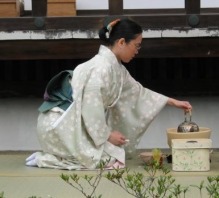
A little history on Tea......
A tea ceremony is performed with up to five guests. The ceremony could be divided into three parts, the preliminary part, the middle part, and the final part.
In the first part, the windows are curtained off by bamboo screens to darken the room, the scroll is removed, and a new one is put in its place.
In the middle part of the ceremony a very simple meal is served, followed by sweet cakes, after which the guests could go and relax in the inner garden.
The final part of the tea ceremony is called nochiseki. The scroll in the alcove is replaced by a floral arrangement, and the water jar, tea caddy and the tea utensils will be placed in the area where the ceremony will take place. The atmosphere of the room is changed to a bright room. The host picks up the ladle, which is a signal for his/her assistant to roll up the bamboo screen, brightening the room once again. The host performs the ceremony in silence, while the guests concentrate on his/her movement. This is the climax of the ceremony. The main guest will then speak to the host while the other guests remain silent. Once the tea has been drunk, silence continues. The fire is smothered by adding more charcoal to the fire pit and the sound of the boiling kettle dies down. Then, thin tea is served, which signifies that the tea ceremony is coming to an end.
Tea drinking has been part of Japans history as early as the Heian period (794-118. Noblemen would enjoy tea as a pastime while they dangled fishing lines in the waters of ponds and listened to music.
Tea, however, did not grow in Japan until the first seeds were brought from China during the T'ang Dynasty (618-905). During the Nara period (710-784), tea plants were being grown on the grounds of some temples and served priests and noblemen as a medicinal beverage. Tea became a luxury in Japan mainly because China wasn't exporting large quantities to Japan. The idea of tea as a beverage didn’t occur until later on. At this time, Japan was imitating the culture of China, but was forced to mold its own traditions and culture due to bad relations between the two countries. Tea was finally introduced in different parts of Japan at the beginning of the Kamakura period (1192-1333).
In 1141, Eisai Myo-an, a priest who left China and founded Zen Buddhism in Japan, brought back tea seeds and planted them in Japan. Eisai was the first to grow tea in Japan purely for religious purposes unlike others who cultivated tea medicinal purposes only. The tea that Eisai grew was of great improvement in quality from the earlier types of teas grown in Japan. This led him to the discovery of powdered tea. Previously, people boiled leaves but Eisai taught people to grind the leaves into a powder, add hot water and stir the mixture before drinking, enhancing the flavor of tea.
Tea was originally used by monks as a stimulant to keep them from falling asleep during their meditations. However, by the early 14th century, the demand for tea and its taste increased substantially and spread to the Samurai Culture.
The system of serving tea was extremely elaborate and originally it consisted of ten cups of four different kinds of tea for each guest. However, soon the number of cups increased to twenty, fifty and seventy, until reaching one hundred cups per person. This required many cups, thus that is why only one cup is used in today's tea ceremony.
Tea Ceremony
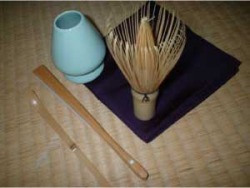
A tea ceremony is performed with up to five guests. The ceremony could be divided into three parts, the preliminary part, the middle part, and the final part. In the first part, the windows are curtained off by bamboo screens to darken the room, the scroll is removed, and a new one is put in its place.
In the middle part of the ceremony a very simple meal is served, followed by sweet cakes, after which the guests could go and relax in the inner garden.
The final part of the tea ceremony is called nochiseki. The scroll in the alcove is replaced by a floral arrangement, and the water jar, tea caddy and the tea utensils will be placed in the area where the ceremony will take place. The atmosphere of the room is changed to a bright room. The host picks up the ladle, a signal for his/her assistant to roll up the bamboo screen, brightening the room once again. The host performs the ceremony in silence, while the guests concentrate on his movement. This is the climax of the ceremony. The main guest will then speak to the host while the other guests remain silent. Once the tea has been drunk, silence continues. The fire is smothered by adding more charcoal to the fire pit and the sound of the boiling kettle dies down. Then, thin tea is served, which signifies that the tea ceremony is coming to an end.
Tea Utensils
Chabaka - A box of standard size used to carry tea utensils and to present the temae, the ceremonial way of preparing and serving tea according to custom.
Chakin - A white linen cloth used for wiping the tea bowl at a tea gathering. It is usually about 15 cm by 27 cm in size. The long edges are loosely hemmed and the short edges bordered only by the selvage of the material.
Chashaku - A tea scoop made by a tea practitioner rather than by a professional. This scoop has a node at the base of the hand with a scoop at the other end. The scoop communicates the personality of its maker. This is because it is created at home with a piece of bamboo and an ordinary knife. Special tea scoops are kept in individual bamboo tubes which are usually signed by their makers or owners. The most commonly used are bamboo although they may be made of various materials such as ivory, silver, and various woods.
Chatsubo - A ceramic jar in which tea is stored for one month during the year-long aging process. When presented in the tearoom, they are often decorated with a carrying net and a complicated set of decorated knots.
Fukusa - A silk cloth used by the host at tea gatherings to purify utensils and grasp the metal knob on top of the kettle. The standard size is 28 cm by 27 cm. Men usually use purple while red is more characteristic of women.
Kama - The kettle used to boil water for tea. They are usually cast iron.
Kensui - The water waste container used at tea gatherings.
Chasen
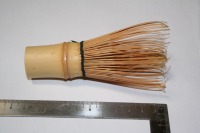
A tea whisk made by cutting one end of a section of bamboo so that one hundred sixty to two hundred tines are formed. A black thread is then wrapped around the base of the tines at the node of the bamboo. Proportion, size, thread color, and the color of the bamboo vary with the whisk's ritual function and the tea school identification of the practitioner. It is used to knead or whip tea.
Chawan
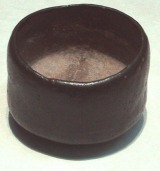
A tea bowl used in the tea ceremony
Hishaku
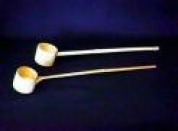
The bamboo water ladle used to move water between the kettle, the cold water container, and the tea bowl
How to Drink Tea....(in Japan Properly)
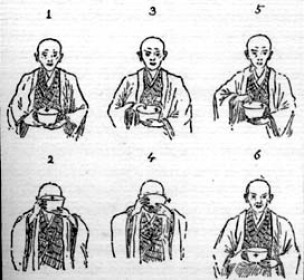
The tea bowl can either be placed in front of the guest or may be placed in the room where the tea was prepared. If the room is small, the guest should not stand up but advance on his knees toward the host. He should also remember the original place where the bowl was stored, so as to return it to its proper place after drinking the tea.
Place the tea bowl outside the border of the tatami you are sitting on. If there is a guest who has been served before you, it is polite to say, "O shoban sasete itadaki masu," or "Please let me accompany you", And to the guest who has not yet been served, you should excuse yourself for drinking first.
You then turn to the host and address him with the words, "O temae o chodai itashimasu,", or "I'll partake of your tea."
Pick up the bowl with your right hand and place it on the palm of your left hand. Put the fingers and our right hand around it, with the thumb facing you, and make a small bow for politeness.
With the bowl still resting on the palm of your left hand, grasp the rim of the bowl with your forefinger and thumb and turn it about ninety degrees clockwise. Take a sip and then comment on how good it tastes, while dropping your right hand on the tatami before your knees.
Drink the remaining tea in small sips and when you come to the last sip, inhale deeply, making an audible sound and finish the tea.
After drinking, the rim of the bowl should be wiped lightly with tissue paper from left to right, as you hold the bowl between forefinger and thumb.
With the bowl still resting on your left palm, turn it counter-clockwise so that it returns to its original position before you drank from it. This is done with the thumb at the edge of the bowl and the other four fingers underneath it.
Place the bowl on the outside of the tatami border and, with your hands on the mat, gaze at the bowl to appreciate its shape. The bowl can be picked up with both hands to view it more closely.
Pick up the bowl and return it to the original position or to the host. The bowl should be turned twice in a 180 degree revolution so that the front of the bowl faces the host when you return it to him/her.
